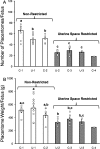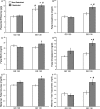Ovine surgical model of uterine space restriction: interactive effects of uterine anomalies and multifetal gestations on fetal and placental growth
- PMID: 20574052
- PMCID: PMC2959109
- DOI: 10.1095/biolreprod.110.085381
Ovine surgical model of uterine space restriction: interactive effects of uterine anomalies and multifetal gestations on fetal and placental growth
Abstract
Intrauterine growth restriction (IUGR) is observed in conditions with limitations in uterine space (e.g., uterine anomalies and multifetal gestations). IUGR is associated with reduced fetal weight, organ growth, and a spectrum of adult-onset diseases. To examine the interaction of uterine anomalies and multifetal gestations, we developed a surgical uterine space restriction model with a unilateral uterine horn ligation before breeding (unilateral surgery). Placentas and fetuses were studied on Gestational Day (GD) 120 and GD 130 (term = 147 days). Unilateral surgery decreased placentome numbers in singleton and twin pregnancies (25% and 50%, respectively) but not unilateral triplets. Unilateral surgery decreased total placentome weight in twin pregnancies (decreased 24%). Fetuses categorized as uterine space restricted (unilateral twin and both groups of triplets) had 51% fewer placentomes per fetus and a 31% reduction in placentomal weight per fetus compared to the nonrestricted group (control singleton, unilateral singleton, and control twin). By GD 130, uterine space-restricted fetuses exhibited decreased weight, smaller crown-rump, abdominal girth, and thoracic girth as well as decreased fetal heart, kidney, liver, spleen, and thymus weights. Lung and brain weights were unaffected, demonstrating asymmetric IUGR. At GD 130, placental efficiency (fetal weight per total placentomal weight) was elevated in uterine space-restricted fetuses. However, fetal arterial creatinine, blood urea nitrogen, and cholesterol were elevated, suggesting insufficient placental clearance. Maternal-to-fetal glucose and triglycerides ratios were elevated in the uterine space-restricted pregnancies, suggesting placental nutrient transport insufficiency. This model allows for examination of interactive effects of uterine space restriction-induced IUGR on placental adaptation and fetal organ growth.
Figures






Similar articles
-
Increasing fetal ovine number per gestation alters fetal plasma clinical chemistry values.Physiol Rep. 2016 Aug;4(16):e12905. doi: 10.14814/phy2.12905. Physiol Rep. 2016. PMID: 27565903 Free PMC article.
-
Pregnancy rates and gravid uterine parameters in single, twin and triplet pregnancies in naturally bred ewes and ewes after transfer of in vitro produced embryos.Anim Reprod Sci. 2006 May;92(3-4):268-83. doi: 10.1016/j.anireprosci.2005.06.013. Epub 2005 Aug 1. Anim Reprod Sci. 2006. PMID: 16076535
-
Ovine fetal renal development impacted by multiple fetuses and uterine space restriction.J Dev Orig Health Dis. 2013 Oct;4(5):411-20. doi: 10.1017/S2040174413000329. J Dev Orig Health Dis. 2013. PMID: 24159370 Free PMC article.
-
SMFM Special Statement: State of the science on multifetal gestations: unique considerations and importance.Am J Obstet Gynecol. 2019 Aug;221(2):B2-B12. doi: 10.1016/j.ajog.2019.04.013. Epub 2019 Apr 16. Am J Obstet Gynecol. 2019. PMID: 31002766 Free PMC article. Review.
-
Nutritionally mediated placental growth restriction in the growing adolescent: consequences for the fetus.Biol Reprod. 2004 Oct;71(4):1055-62. doi: 10.1095/biolreprod.104.030965. Epub 2004 Jun 16. Biol Reprod. 2004. PMID: 15201203 Review.
Cited by
-
The hemodynamic basis for positional- and inter-fetal dependent effects in dual arterial supply of mouse pregnancies.PLoS One. 2012;7(12):e52273. doi: 10.1371/journal.pone.0052273. Epub 2012 Dec 20. PLoS One. 2012. PMID: 23284965 Free PMC article.
-
Blood Biomarker Profile Alterations in Newborn Canines: Effect of the Mother's Weight.Animals (Basel). 2021 Aug 5;11(8):2307. doi: 10.3390/ani11082307. Animals (Basel). 2021. PMID: 34438764 Free PMC article.
-
Uterine artery leptin receptors during the ovarian cycle and pregnancy regulate angiogenesis in ovine uterine artery endothelial cells†.Biol Reprod. 2017 Apr 1;96(4):866-876. doi: 10.1093/biolre/iox008. Biol Reprod. 2017. PMID: 28339937 Free PMC article.
-
True uterus didelphys in she-camel: a case report and review of literature.Front Vet Sci. 2024 Jun 26;11:1419234. doi: 10.3389/fvets.2024.1419234. eCollection 2024. Front Vet Sci. 2024. PMID: 38993277 Free PMC article.
-
Placental insufficiency and heavier placentas in sheep after suppressing CXCL12/CXCR4 signaling during implantation†.Biol Reprod. 2023 Dec 11;109(6):982-993. doi: 10.1093/biolre/ioad122. Biol Reprod. 2023. PMID: 37724932 Free PMC article.
References
-
- Grimbizis GF, Camus M, Tarlatzis BC, Bontis JN, Devroey P.Clinical implications of uterine malformations and hysteroscopic treatment results. Hum Reprod Update 2001; 7: 161–174. - PubMed
-
- Kiely JL, Brett KM, Yu S, Rowley D.Low birth weight and intrauterine growth retardation. Wilcox LS, Marks JS.From Data To Action: CDC's Public Health Surveillance For Women, Infants, And Children. Washington, DC: US Department of Health and Human Services; 1994: 185–202.
-
- Romo A, Carceller R, Tobajas J.Intrauterine growth retardation (IUGR): epidemiology and etiology. Pediatr Endocrinol Rev 2009; 6(suppl 3):332–336. - PubMed
-
- Reichman D, Laufer MR, Robinson BK.Pregnancy outcomes in unicornuate uteri: a review. Fertil Steril 2009; 91: 1886–1894. - PubMed
-
- Cohen A, Chhibber G.Obstetric complications of congenital anomalies of the paramesonephric ducts. Semin Reprod Endocrinol 1986; 4: 59–65.
Publication types
MeSH terms
Grants and funding
LinkOut - more resources
Full Text Sources
Medical

